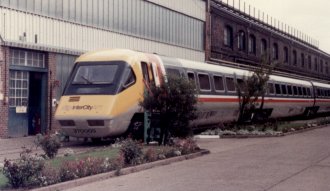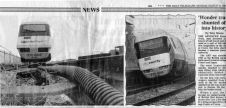DfT: sitting on the SoFA
In 2006-07 most of the first round of franchises came to the end of their terms and were put up for re-letting. In an unanticipated round of blood letting in search of “best value for the Department for Transport”, few of them were retained by the incumbents.
The early refranchising round was ushered in by the news that First Great Western (not a 1996 franchisee having bought out the original management team, but a TOC which did retain its franchise in the re-bidding) had gone back after a few weeks to renegotiate their terms and their DfT-approved rolling stock list, amidst widespread public protests from their passengers concerning short trains and withdrawn services. The DfT protested that fGW were free to restore services to any level they wished - but forgot to mention that fGW were under a tight agreement as to their bid for costs to run the services, or that their rolling stock had been allocated by the DfT to other forthcoming refranchises. The reason for DfT approving changes despite their own protestations of innocence in the cuts was that to restore the services altered, combined or withdrawn would cost more than the bid the DfT themselves had selected as "best value" for the tightly specified franchise.
One original 1996 franchisee to keep their franchise was Stagecoach with the TOC once known as South West Drains, thanks to a complete turn-around in their performance measures and passenger satisfaction from bottom to top. What probably also helped Stagecoach keep their franchise was getting the long-delayed "Juniper" units (an embarrassing bit of post-privatisation rolling stock ordering) into service on the Reading line, thus saving the DfT from even more embarrassing "trains that never turned a wheel in service" stories at a time when public focus turned to overcrowding and the need to restore post-privatisation cuts in train lengths.
Before a year was out came the collapse of GNER who had bid to retain their franchise on terms widely seen as ambitious, and were simultaneously hit by their parent withdrawing financial guarantees at the same time as business shrank following the July 2006 London bombings. They had no financial margin due to the tightness of their bid. After GNER, no further franchises went to the incumbent - I presume the DfT paniced and tried in this way to stop the increasing progression of optimistic bids from existing franchise holders.
Thus it became clear in 2007 that keeping the railway usable for its passengers and keeping the railway organised stably during temporary lean times were no longer political objectives - involving as they did "reducing value" for the DfT. Though at least since the IEP (Intercity Express replacement Programme) was mooted the DfT has now given up any pretence of not allocating the rolling stock to Train Operating Companies ...
Most recently, Virgin, another early first-generation franchisee, have lost their Cross Country franchise to Arriva. Virgin retained their West Coast franchise, whose length was previously extended to 2012 on favourable management terms in compensation for their losses under the Railtrack-inspired planning and management disaster known as West Coast Passenger Upgrade. PUG, like the APT project twenty-five years ago, was an object lesson in railway engineering evolution rather than airline inspired revolution — but one which cost many times more than the entire APT project, which delivered less than APT would have, and which inconvenienced passengers throughout years of topsy-turvey engineering closures and disruptions. Still the Pendolinos look nice, even though at 125 mph (200 km/h) they are scheduled slower than APT's 1981 speed of no less than 140 mph (225 km/h).
Also in 2007 Network Rail's first financial "Control Period" aka CP2 came to an end, and with it the generous funding they had been given to recover from the Railtrack mess. CP1 covered the disastrous tenure of John Major's and John Prescott's Railtrack, during which the reliability and safety of rail trackwork and signalling degenerated to appalling levels whilst the Directors sold off railway property they had inherited from BR in order to fund badly managed mega-projects and pay shareholder dividends.
For Network Rail 2007-2012 (CP3), a new set of funding rules are being tried. The DfT were asked by the independent Rail Regulator to come up with two documents: a Statement of Funds Available (the SoFA) and the High Level Output Statement (HLOS), a specification of what they wanted the railway to achieve. The hope is - and I write as these documents have just been published - that requiring the DfT to focus their minds in this manner will lead to a more stably funded railway, a more sustainable railway in the medium to long term, and one less subject to change of direction from Whitehall each time a new crisis or new flavour-of-the-month arises. The same goals as we originally hoped for from privatisation itself, in fact !
And so the money-go-round continues. Did you realise that the overcrowded privatised railway today is costing more than three times as much total from your and my pocket than BR did, at a corresponding time in the economic cycle and similar passenger levels ?
There was an "old BR" black joke that running a railway would be easy if it weren't for the passengers. If you thought party politicians meddled too much with British Rail, you've not kept track of the machinations of the transport Civil Servants "playing trains" during ten years of privatised railway ! Writing this in September 2007 the situation is not yet clear, but let us hope that the Mandarins of Transport have learnt their own corresponding lesson after once again getting their fingers - and our pockets - financially burnt.
Links
BBC / UK / Politics / The great train sell-off: Who dunnit? (20th October 2000)
The Guardian: The £10bn rail crash (April 2004). “James Meek reveals the saga of incompetence, greed and delusion behind Britain's biggest public works project” - the Railtrack West Coast Passenger Upgrade (Archive copy)





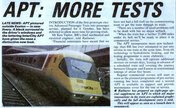
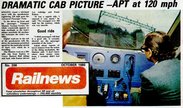
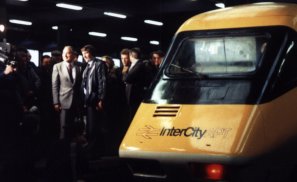
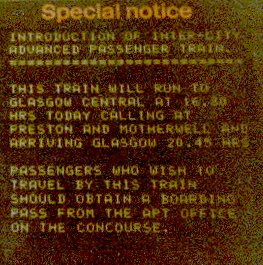
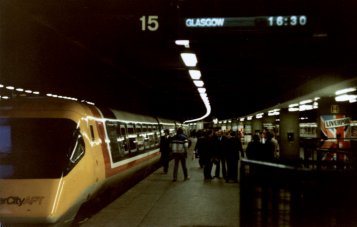
 However the major problem was that the night of 7th-8th December
brought some of the worst winter weather for several years to the whole
of England. During the following three days British Rail tried to continue the
APT service, but — as with most other stock on the network — moisture
kept freezing, not in the high-speed hydraulic brakes, but in the air
brake lines which were supposed to take over at lower speeds. On the
Wednesday the southbound trip was cancelled at Crewe, amongst service
problems all around, and the train withdrawn from passenger service.
However the major problem was that the night of 7th-8th December
brought some of the worst winter weather for several years to the whole
of England. During the following three days British Rail tried to continue the
APT service, but — as with most other stock on the network — moisture
kept freezing, not in the high-speed hydraulic brakes, but in the air
brake lines which were supposed to take over at lower speeds. On the
Wednesday the southbound trip was cancelled at Crewe, amongst service
problems all around, and the train withdrawn from passenger service.